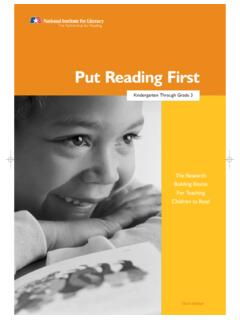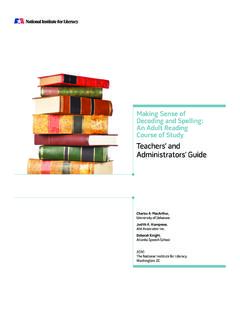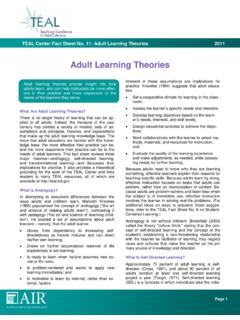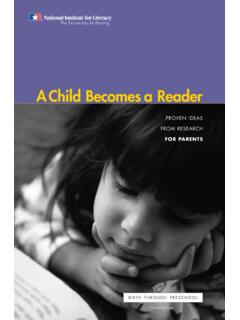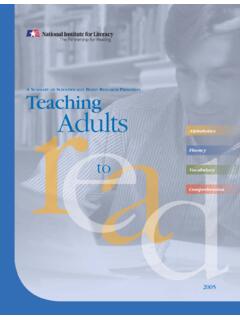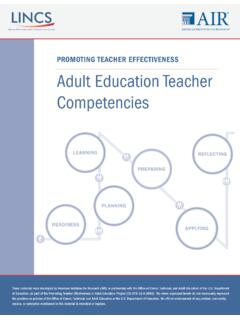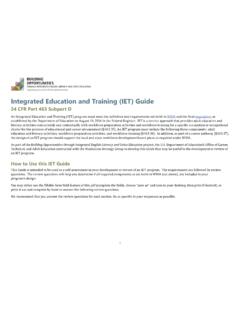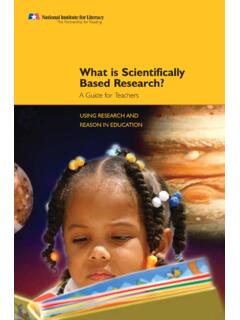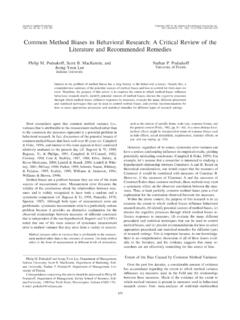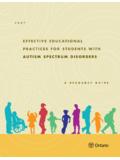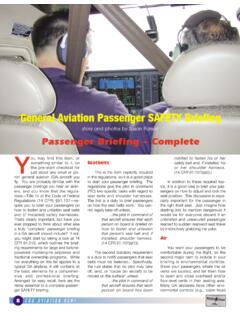Transcription of Deeper Learning through Questioning - ed
1 TEAL Center Fact Sheet No. 12: Deeper Learning through Questioning 2013. Deeper Learning through Questioning Most of the time, I-R-E questions expect one right an- Asking good questions is central to Learning and swer. The I-R-E sequence consists of the teacher ini- sometimes can be more important than getting tiating a question, the student responding with an an- the answers, particularly when the questions en- swer, and the teacher evaluating the student's re- courage students to think critically. Skill in the art sponse or giving feedback. Each round of interaction of Questioning lies at the basis of all good teach- involves one student at a time, with the teacher ask- ing, evaluating, and then moving on to question an- ing (Betts, 1910, p.)
2 55). Equally important is other student. With this model, teachers typically talk helping students use self- Questioning to monitor about two-thirds of the time (Cazden, 2001), spending their Learning . This fact sheet focuses on both an estimated 35 50 percent of their instructional time teacher Questioning and student self- Questioning . Questioning students and asking one to three ques- tions per minute. About Questioning A number of recent studies have begun to investigate Questioning as an instructional tool can be traced the possibility of making classroom interaction more back to the fourth century BCE, when Socrates used dialogic ( , Gibbons, 2002; Nystrand, 1997; Wells, questions and answers to challenge assumptions, 1999).
3 Learning is likely to be more effective when expose contradictions, and lead to new knowledge students are actively involved in a dialogue in which and wisdom. Used in this way, Questioning can be an they are co-constructors of meaning. Coming to know undeniably powerful teaching approach. By his com- something requires learners to actively participate as ment at his trial for heresy, An unexamined life is not they construct and progressively improve their under- worth living, Socrates made it clear that he also un- standing through the exploration of ideas (Bransford, derstood the importance of self-examination, or ques- Brown, & Cocking, 2000).
4 Integral to this process is tioning oneself. posing thought-provoking questions and inviting stu- dents to make predictions, summarize, link texts with When teachers ask higher order questions and give one another and with background knowledge, gener- students opportunities to develop deep explanations, ate and answer text-related questions, clarify under- Learning is enhanced across content areas. Higher standings, muster relevant evidence to support an order questions often start with question stems such interpretation, and interrelate reading, writing, and as Why, What caused, How did it occur, What if, How discussion (Applebee, Langer, Nystrand, & Gamoran, does it compare, or What is the evidence.)
5 When 2003, p. 693). teachers ask higher order questions and encourage explanations, they help their students develop im- Questions are typically classified by the level of cogni- portant critical thinking skills. By modeling good ques- tive demand required to answer them. The best tioning and encouraging students to ask questions of known system for categorizing the cognitive level of themselves, teachers can help students learn inde- questions is Bloom's taxonomy (1956), in which six pendently and improve their Learning . levels of cognitive demand move from the lowest- order processes to the highest.
6 Lower-order questions Teacher Questioning ask students to recall and comprehend material that was previously read or taught by the teacher. Higher- A traditional teacher-led question-and-answer ap- order questions ask students to use information previ- proach that is widely used is recitation, or the Initi- ously learned to create or support an answer with log- ate-Response-Evaluate (I-R-E) model of Questioning ically reasoned evidence. Both higher- and lower- (Mehan, 1979). Although this model can be an effec- order questions are useful and have their place in the tive way to check for factual knowledge or recall, it teaching- Learning process, but they serve different typically does not encourage higher-order thinking.
7 Purposes. Page 1. TEAL Center Fact Sheet No. 12: Deeper Learning through Questioning 2013. A recent revision of Bloom's taxonomy (Anderson & Memory questions focus on identifying, naming, Krathwohl, 2001) expresses the levels as verbs in- defining, designating, and responding with yes or stead of nouns. Both the 1956 and the revised 2001 no. Key words are who, what, where, when. taxonomies are shown in the figure below. Convergent thinking questions focus on explain- ing, stating relationships, comparing, and con- trasting. Key words are why, how, in what way. Bloom Revised Bloom Divergent thinking questions focus on predicting, Evaluation Create hypothesizing, inferring, and reconstructing.
8 Key Synthesis Evaluate words are imagine, suppose, predict, if then , Analysis Analyze how might, can you create, what are some possi- Application Apply ble consequences. Comprehension Understand Evaluative thinking questions focus on valuing, Knowledge Remember defending, judging, and justifying choices. Key words are defend, judge, justify, what do you A meta-analysis of studies of instructional methods think, what is your opinion. (Redfield & Rousseau, 1981) found a positive rela- tionship between the predominant use of higher-level The K-W-L Strategy questions during instruction and student gains on An example of teacher Questioning that supports tests of both factual recall and application of thinking thinking and discussion is the K-W-L strategy, which skills.
9 Studies of classroom instruction (Gall, 1970; helps students learn from expository text in any con- Hare & Pulliam, 1980) confirm that only 20 percent of tent area (Ogle, 1986). Using this strategy, the teach- questions posed by teachers require more than simple er models for students how to create a three-column factual recall, clearly pointing to a need for more chart, labeling the first column K, the middle column teachers to become familiar with and use higher-order W, and the third column L. The teacher then introduc- questions to encourage Deeper Learning . es the topic of the expository text that students are to read and asks students to tell what they know about The following questions are examples of those that the topic of the text ( , World War II).
10 The teacher teachers can ask to encourage Deeper student think- asks students to brainstorm words, terms, or phrases ing and Learning . from their background knowledge that they associate Questions that ask for more evidence: How do you with the topic and to record these in the K column of the chart. Next, the teacher asks students what they know that? What data is that claim based on? want to learn about the topic or what they think they Questions that ask for clarification: Can you put will learn about the topic. As students predict what that another way? What do you mean by that?
